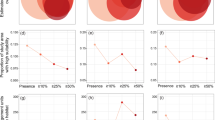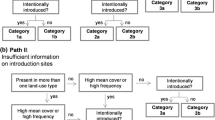Abstract
Designing efficient management strategies for already established invasive alien species is challenging. Here, we ask whether environmental suitability, as predicted by species distribution models, is a useful basis of cost-effective spatial prioritization in large-scale surveillance and eradication programmes. We do so by means of spatially and temporarily explicit simulations of the spread of a case study species (Ambrosia artemisiifolia L.) in Austria and southern Germany under different management regimes. We ran these simulations on a contiguous grid of the study area with each grid cell (~35 km²) characterized by a habitat suitability value derived from the predictions of a species distribution model. The management regimes differed in terms of (a) a minimum habitat suitability rank p (suitability threshold) used to separate cells for surveillance from those which are not controlled; and (b) the strategy for selecting cells for annual campaigns from the pool defined by p. According to the results (i.e., number of cells infested in 2050 as well as infested on average per year) the most efficient way to base surveillance on suitability is to define the temporal sequence of management according to the grid cells’ suitability ranks. Management success declines sharply when the suitability threshold is set too high, but only moderately when it is set too low. We conclude that accounting for environmental suitability is important for large-scale management programmes of invasive alien species and that species distribution models are hence useful tools for designing such programmes.




Similar content being viewed by others
References
Bogich T, Shea K (2008) A state-dependent model for the optimal management of an invasive metapopulation. Ecol Appl 18:748–761
Brandes D, Nitzsche J (2007) Verbreitung, Ökologie und Soziologie von Ambrosia artemisiifolia L. in Mitteleuropa. Tuexenia 27:167–194
Broennimann O, Treier UA, Müller-Schärer H, Thuiller W, Peterson AT, Guisan A (2007) Evidence of climatic niche shift during biological invasion. Ecol Lett 10:701–709
Chauvel B, Dessaint F, Cardinal-Legrand C, Bretagnolle F (2006) The historical spread of Ambrosia artemisiifolia L. in France from herbarium records. J Biogeogr 33:665–673
Diez JM, Williams PA, Randall RP, Sullivan JJ, Hulme PE, Duncan RP (2009) Learning from failures: testing broad taxonomic hypotheses about plant naturalization. Ecol Lett 12:1174–1183
Dullinger S, Kleinbauer I, Peterseil J, Smolik M, Essl F (2009) Niche based distribution modelling of an invasive alien plant: effects of population status, propagule pressure and invasion history. Biol Inv 11:2401–2414
Epanchin-Niell RS, Hastings A (2010) Controlling established invaders: integrating economics and spread dynamics to determine optimal management. Ecol Lett 13:528–541
Essl F, Dullinger S, Kleinbauer I (2009) Changes in the spatio-temporal patterns and habitat preferences of Ambrosia artemisiifolia during its invasion of Austria. Preslia 81:119–133
Essl F, Dullinger S, Rabitsch W et al (2011a) Reply to Keller and Springborn: no doubt about invasion debt. Proc Nat Acad Sci USA 108:E221
Essl F, Dullinger S, Rabitsch W et al (2011b) Socioeconomic legacy yields an invasion debt. Proc Natl Acad Sci USA 108:203–207
Fox JC, Buckley YM, Panetta FD, Bourgoin J, Pullar D (2009) Surveillance protocols for management of invasive plants: modelling Chilean needle grass (Nassella neesiana) in Australia. Divers Distrib 15:577–589
Giljohann KM, Hauser CE, Williams NSG, Moore JL (2011) Optimizing invasive species control across space: willow invasion management in the Australian Alps. J Appl Ecol 48:1286–1294
Gladieux P, Giraud T, Kiss L, Genton BJ, Jonot O, Shykoff JA (2011) Distinct invasion sources of common ragweed (Ambrosia artemisiifolia) in Eastern and Western Europe. Biol Inv 13:933–944
Guisan A, Thuiller W (2005) Predicting species distribution: offering more than simple habitat models. Ecol Lett 8:993–1009
Hauser CE, McCarthy MA (2009) Streamlining ‘search and destroy’: cost-effective surveillance for pest management. Ecol Lett 12:683–692
Hulme P (2003) Biological invasions: winning the science battles but losing the conservation war? Oryx 37:178–193
Hulme PE, Pyšek P, Nentwig W, Vilà M (2009) Will threat of biological invasions unite the European Union? Science 324:40–41
Kot M, Lewis MA, van den Driessche P (1996) Dispersal data and the spread of invading organisms. Ecology 77:2027–2042
Kriticos DJ, Sutherst RW, Brown JR, Adkins SW, Maywald GF (2003) Climate change and the potential distribution of an invasive alien plant: Acacia nilotica ssp. indica in Australia. J Appl Ecol 40:111–124
Krug RM, Roura-Pascual N, Richardson DM (2010) Clearing of invasive alien plants under different budget scenarios: using a simulation model to test efficiency. Biol Inv 12:4099–4112
Lambdon PW, Pyšek P, Basnou C et al (2008) Alien flora of Europe: species diversity, temporal trends, geographical patterns and research needs. Preslia 80:101–149
McNeely JA, Mooney HA, Neville LE, Schei PJ, Waage JK (2001) Global strategy on invasive alien species. IUCN Gland, Switzerland
Mehta SV, Haight RG, Homans FR, Polasky S, Venette RC (2007) Optimal detection and control strategies for invasive species management. Ecol Econ 61:237–245
Moody ME, Mack RN (1988) Controlling the spread of plant invasions: the importance of nascent foci. J Appl Ecol 25:1009–1021
Moran PAP (1950) Notes on continuous stochastic phenomena. Biometrika 37:17–23
Myers JH, Bazely DR (2003) Ecology and control of introduced plants. Cambridge University Press, Cambridge
Nelder J, Mead R (1965) A simplex-method for function minimization. Comput J 7:308–313
Niklfeld H (1998) Mapping the flora of Austria and the eastern Alps. Revue Valdotaine d’Histoire Naturelle 51:53–62
Panetta FD, Cacho O, Hester S, Sims-Chilton N, Brooks S (2011) Estimating and influencing the duration of weed eradication programmes. J Appl Ecol 48:980–988
Regan TJ, Chades I, Possingham HP (2011) Optimally managing under imperfect detection: a method for plant invasions. J Appl Ecol 48:76–85
Reinhardt F, Herle M, Bastiansen M, Streit B (2003) Ökonomische Folgen der Ausbreitung von Neobiota. Umweltbundesamt Texte 79:1–248
Schönfelder P (1999) Mapping the flora of Germany. Acta Botanica Fennica 162:43–53
Shine C, Kettunen M, Genovesi P, Essl F, Gollasch S, Rabitsch W, Scalera R, Starfinger U, ten Brink P (2010) Assessment to support continued development of the EU Strategy to combat invasive alien species. Final Report for the European Commission. Technical report, Institute for European Environmental Policy (IEEP), Brussels, Belgium
Smolik MG, Dullinger S, Essl F, Kleinbauer I, Leitner M, Peterseil J, Stadler LM, Vogl G (2010) Integrating species distribution models and interacting particle systems to predict the spread of an invasive alien plant. J Biogeogr 37:411–422
Taramarcaz P, Lambelet C, Clot B, Keimer C, Hauser C (2005) Ragweed (Ambrosia) progression and its health risks: will Switzerland resist this invasion? Swiss Med Wkly 135:538–548
Thuiller W, Albert C, Araújo MB et al (2008) Predicting global change impacts on plant species’ distributions: future challenges. Perspect Plant Ecol Evol Syst 9:137–152
Thuiller W, Lafourcade B, Engler R, Araújo MB (2009) BIOMOD—a platform for ensemble forecasting of species distributions. Ecography 32:369–373
Underwood EC, Klinger R, Moore PE (2004) Predicting patterns of non-native plant invasions in Yosemite National Park, California, USA. Divers Distrib 10:447–459
Veitch CR, Clout MN (2002) Turning the tide: the eradication of invasive species. IUCN-The World Conservation Union, Auckland
Vilà M, Basnou C, Pyšek P et al (2010) How well do we understand the impacts of alien species on ecosystem services? A pan-European, cross-taxa assessment. Front Ecol Environ 8:135–144
Vilà M, Espinar JL, Hejda M, Hulme PE, Jarošik V, Maron JL, Pergl J, Schaffner U, Sun Y, Pyšek P (2011) Ecological impacts of invasive alien plants: a meta-analysis of their effects on species, communities and ecosystems. Ecol Lett 14:702–708
Vogl G, Smolik M, Stadler LM, Leitner M, Essl F, Dullinger S, Kleinbauer I (2008) Modelling the spread of ragweed: effects of habitat, climate change and diffusion. Eur Phys J Special Top 161:167–173
Williamson M, Dehnen-Schmutz K, Kühn I, Hill M, Klotz S, Milbau A, Stout J, Pyšek P (2009) The distribution of range sizes of native and alien plants in four European countries and the effects of residence time. Divers Distrib 15:158–166
Acknowledgments
This work was supported by the Austrian Academy of Sciences within the Global Change Programme. We are grateful to R. May, H. Niklfeld, L. Schratt-Ehrendorfer, and T. Englisch for access to the data of the Floristic Mapping Projects of Austria and Germany. Valuable unpublished distribution data have been provided by numerous other colleagues. We are grateful to two anonymous reviewers for their constructive comments and in particular to editor Joslin Moore for her detailed and encouraging suggestions.
Author information
Authors and Affiliations
Corresponding author
Electronic supplementary material
Below is the link to the electronic supplementary material.
Rights and permissions
About this article
Cite this article
Richter, R., Dullinger, S., Essl, F. et al. How to account for habitat suitability in weed management programmes?. Biol Invasions 15, 657–669 (2013). https://doi.org/10.1007/s10530-012-0316-8
Received:
Accepted:
Published:
Issue Date:
DOI: https://doi.org/10.1007/s10530-012-0316-8




